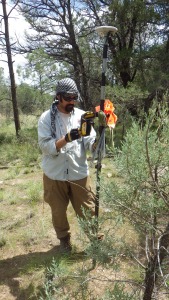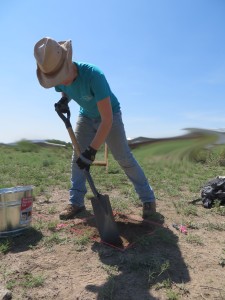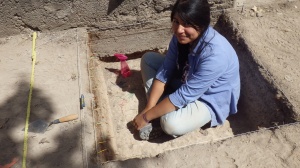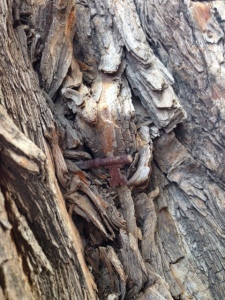Presented by: Erin C. Rodriguez, Doctoral Candidate UC Berkeley at the Society for Historical Archaeology Conference, 2015 in Seattle, Washington
Also available as .pdf : Rodriguez_SHA15
Introduction
The need for more diversity in professional archaeology is increasingly prevalent in disciplinary discourse. Professional committees, such as GMAC which has sponsored this session, as well as scholarships and diversity initiatives in hiring, speak to awareness of the need to build a more inclusive archaeology. While these measures do have a positive impact and should be encouraged and expanded, they fail to challenge the pedagogical structure of archaeology which has marginalized underrepresented communities. As the study of the human past, archaeology must include voices and perspectives from professionals as diverse as the people we study. To accomplish this we need concrete, substantial methods to change the dialog about who can be an archaeologist at every level of training, but most especially at the undergraduate level where interest in archaeology as a profession often begins.
This paper is particularly concerned with undergraduate field education as one of the defining points in a new archaeologists’ career as well as a crucial time where lack of inclusiveness can drive potential future archaeologists away from the discipline. This paper discusses how a feminist and queer pedagogy applied to field education results in specific, concrete approaches in increasing inclusiveness. The focus of the paper is the Fort Davis Archaeological Project field school, run by myself and co-chair of this session, Katrina Eichner, under the mentorship of Professor Laurie Wilkie.
Fort Davis Archaeological Project
The Fort Davis Archaeological Project (FODAAP) was initiated by Laurie Wilkie and Katrina Eichner in 2011, I joined the project in 2013, which was also the first year in which undergraduate students participated. The project investigates relationships between civilian and military residents of the Fort Davis military post and surrounding towns during the late 1800s when African American Buffalo soldiers were stationed at the fort during reconstruction. In 2014 a second field season included five undergraduate students in addition to graduate student staff from UC Berkeley. Four sites in the surrounding town were investigated during this season. A third season is planned for 2015. For each field season, almost every student who applied was accepted. So far, ten undergraduate students have participated in the project, nine of which come from underrepresented groups in archaeological undergraduate education, whether by race, ethnicity, queer-identifying, or age. Several students also have differences in learning style and physical ability. Myself and Katrina also fall into these categories. However, in the interests of privacy, I will not discuss any of our students specifically, but instead some of the measures we have taken to create a safe, supportive environment for students from diverse backgrounds.
Feminist and Queer Theories of Pedagogy
I am going to briefly discuss how our project utilizes feminist and queer approaches to pedagogy in creating an inclusive field school environment through initiatives to deconstruct the power structures and hierarchy central to the student-instructor relationship, by redefining the construction of knowledge, power, and voice, and by redefining ‘difference’ as an opportunity for community rather than a source of tension and disruption. Using this background, FODAAP’s field school is not only creating spaces for students from underrepresented communities, but advocating for the restructuring of archaeological education to remove preconceived ideals of who can do archaeology. Additionally, as field schools include more than just education in field and laboratory techniques, a queer field pedagogy must also include the daily and social life of the project which constitute the pedagogical environment in which learning takes place.
Field school directors, in our roles as educators and through the process of selecting field school participants, directly control access to archaeological knowledge and training. When field schools determine who can participate in projects based on criteria other than archaeological ability, they reinforce the positionality of the directors and police the boundaries of who can be an archaeologist. Restructuring field education requires that this power hierarchy between instructors and students be reorganized. FODAAP approaches this by identifying what needs to be done archaeologically (excavation, mapping, note taking, survey, lab work, etc) and presenting those goals as our expectations to students. We then create dialog with the students to identify how we can best support them in completing these tasks to the necessary standards. In 2014 FODAAP investigated five sites in Fort Davis including two residences and a sawmill. Two students have expressed interest in returning for 2015, and four students are working on senior theses through the project.
Our discursive approach to field education relies upon an empowered student who knows their own educational needs and can articulate them to instructors. In this discursive student-instructor model, the instructor identifies expectations and requirements, but works with students in the production of knowledge rather than dictating how learning must be accomplished. This creates an inherent teamwork approach to field education, and specifically a teamwork approach that supports multivocality and treats difference as an opportunity for community, rather than teamwork which washes away differences for the surface appearance of unity.
FODAAP Field School Case Study
In the following section I am going to discuss several concrete ways in which FODAAP works to create an inclusive, supportive environment for our field school students. Underrepresented communities of students which FODAAP has worked with include: queer-identifying students, students of color, students older than 25, student from less affluent backgrounds, students with differences in physical ability, students with learning differences, non-neurotypical students, and students with dietary restrictions. This is not an exhaustive list of underrepresented communities in archaeology, or in field schools, but represents those communities with which FODAAP has the most experience. In the interest of time I am not going to discuss all of these topics, but rather those with which I have the most familiarity, both through FODAAP and through my own experiences as a field school student and staff on other projects. The focus for the remainder of this paper will be on students from less-affluent backgrounds, queer students, and students with dietary restrictions.
Affordability
The cost of field schools can be a major deterrent to students from less-affluent backgrounds, and due to the correlation between income and race/ethnicity this therefore also affects racial and ethnic diversity in archaeology. When field schools cost up to $4000 (or more) in addition to transportation costs and the loss of summer income, this can be prohibitive for many students who have a strong interest in the discipline and are promising scholars. While scholarships are available for many field programs, particularly those under an organizational umbrella, this only helps a few students and does not substantially affect the professional community. Rather than providing a few scholarships to meet diversity quotas, a more inclusive archaeology requires assessing how we fund projects and how we fund field schools. With granting sources also limited, this may mean a more modest approach to field projects or creative approaches to funding fieldwork.
As a project, FODAAP charges students the cost of their room and board, plus a contribution to the project costs, the total of which comes to between $1500 and $2000 for a six week field school. We do not require students to register for credits, which substantially lowers the cost of participation. Students have the option of registering for independent study credits with Professor Wilkie either over the summer or during the following semester. Regardless of credit load, all students receive a full field education with training in excavation, mapping, survey, lab procedures, as well as evening lectures and visits to local archaeological and historic sites.
FODAAP also keeps student costs low by procuring modest housing and affordable food choices. We live in comfortable two to four person cabins outside of Fort Davis, with easy access to the town and the sites. Students are responsible for their own breakfast and we provide a variety of sandwich options for lunches. Since we do not have cooking facilities in the cabins, dinners are eaten at restaurants in town where project members pick from a limited menu.
Housing and Gender
Housing and gender can be difficult topics in field projects where communal housing along male/female lines is typical. For students and professionals who do not fall into comfortable man/woman categories gendered housing can cause discomfort or a sense of being invisible by the act of being reduced into either ‘man’ or ‘woman’. FODAAP’s mission to create a safe environment for queer and gender non-conforming students is ongoing and relies primarily on dialog with students about their needs. We do not ask students their gender on our application and instead ask if students are comfortable in multi-gendered housing and, if not, what their preferences are. Our gender guidelines for working with students are 1) ask for students’ pronouns, not their gender; 2) ask students’ housing preferences instead of automatically assigning spaces based on gendered assumptions; 3) have gender neutral housing options; 4) enforce a policy of support, acceptance, and inclusion for all team members.
Our most important strategy in addressing concerns of our students is getting to know our students individually before the field season starts. This gives the students a space to raise their concerns and discuss how the project can address their needs both privately amongst the project team and in the community. This pertains not only to issues of gender but also to personal living preferences and roommate issues which inevitably are part of communal living. Housing decisions are made by the project staff and are usually based on age and temperament (how much social vs. private time a student says they need). All housing choices are approved by the students before they are finalized.
Our individual meetings with students prior to the start of the field school are important not only for discussing housing concerns, but also for establishing dialog with each individual student about their personal and educational needs regardless of background. We use this space to establish the professional nature of the project and to dispel any remaining ideas that field school is vacation. We discuss the project schedule, the season’s goals, and what we expect from our students both during field work and as representatives of the project in the community. The student has the chance to privately voice any concerns they may have, and we use the time to better understand how to support each individual student so that they can meet project expectations. In addition to housing, we discuss differences in learning style and physical ability and how the project can best support the student’s educational needs. We discuss homesickness and the isolation of living in a small rural community with limited phone and internet for two months, and any other concerns the students may have based on our description of the project. These dialogs create spaces not only for students from underrepresented populations, but for all students to know that they are heard and to know that the project is committed to their education.
Diet
I hesitated over including a section on dietary restrictions as it seems obvious to me that a student’s diet has nothing to do with whether they have the potential to be a successful professional archaeologist. However, it is something I have encountered repeatedly both in my own experience and in the experiences of others. Additionally, specific diets or dietary restrictions often correlate with other communities of identity, creating an additional barrier to inclusion in field projects. Examples of common dietary restrictions include: vegetarian and vegan diets, nut allergies, lactose intolerance, gluten intolerance, soy allergies, religious restrictions, shellfish allergies, diabetes, egg allergies, etc. To date, FODAAP has included students and staff with gluten-free, lactose intolerance, nut allergies, and vegan diets. Our policy on dietary restrictions is that the project staff must know about all dietary issues when applications are submitted and students need to have enough awareness of their dietary needs to tell us what is necessary.
Communal living and eating arrangements on field projects are the most common reasons I have encountered for restricting access to students (and staff) with dietary restrictions. However, excluding students on the basis of inconvenience or project staff’s unfamiliarity with dietary restrictions, is still exclusion and denies a critical education opportunity to potential future professionals without regard to their archaeological ability.
Rather than focusing on the problems related to accommodating dietary restrictions, FODAAP works with our students to find ways to keep them healthy while minimizing the effect on other students and the day to day functioning of the project. Project lunches include several options (usually peanut butter, tuna, and deli meats). Vegan bread is easy to find, and gluten-free bread alternatives can be provided. Each project participant makes their own lunch, which ensures that everyone has something they can eat and reduces worry about cross-contamination.
In seasons where the project has had cooking facilities, cooking duties are shared amongst project staff and students and meals must include options for each team member. In years where the project eats dinners at local restaurants, students pick their own meals. Additionally, when the project has had vegan students (to date the most difficult dietary restriction to accommodate in rural Texas), we give students the option of using the money that would go to their dinner to buy their own food in the grocery store and make their own meals.
Discussion
FODAAP’s approach to inclusive undergraduate field education relies on a student-instructor model in which the student is responsible for their own educational needs and can articulate those to the instructor. However, in reality, not all students can meet this challenge. Some students are unaccustomed to taking independent responsibility for their education, as well as unfamiliar with the intense living and working environment of the field. Additionally, many team members have not lived and worked with diverse groups and may be unsure how to comport themselves, creating internal tensions and discord. However, overall our approach has resulted in students with a strong sense of their own abilities and interests. Many students continue their relationship with the project after their field school is complete through senior theses, participation in UC Berkeley’s Undergraduate Research Apprenticeship Program, and by returning to the field as project staff.
In order to encourage our students to develop independence in their education we continue our dialog-focused interactions with students into the field. With a low student to staff ratio we are able to support our students’ professional development as well as their field education. However, the burden of empowerment and responsibility is still on the students – providing most with the space and support to develop their own professional voice.
Another challenge in promoting student empowerment is including diverse staff on the project to act as mentors to students from similar backgrounds. Part of this challenge is being met by having returning students serve as junior staff, and the project is also considering a broader search for additional staff to join the team.
Conclusion
Central to FODAAP’s approach to inclusive undergraduate field education is a focus on communication and dialog between project instructors and students. Rather than requiring students to conform to a model of how fieldwork must be done, the project works with students to accomplish project goals while recognizing differences in students’ living and learning requirements. Rather than creating a few spaces for students from underrepresented communities by promoting tolerance and relying on scholarships, FODAAP uses a queer pedagogy to restructure archaeological education so that students are not defined by the distinction between commonly represented and underrepresented communities, while still retaining awareness and the perspectives of diverse backgrounds. FODAAP advocates that rather than encouraging our students to fit a preconceived ideal of who can be an archaeologist, we must change our vision of who is an archaeologist.
References
Britzman, Deborah P. 1995. “Is there a Queer Pedagogy? Or, Stop Reading Straight.” Educational Theory 45.2: 151-165.
Lin, Huei-Hsuan. 2004. Cartography of (Un)Intelligibility: A Migrant Intellectual’s Tale of the Field. Interrupting Heteronormativity. Mary Queen, Kathleen Farrell, and Nisha Gupta, Editors. Syracuse.
Misawa Mitsunori. 2006. Queer Race Pedagogy in Adult Higher Education: Dealing with Power Dynamics and Positionality of Gay Students of Color. Adult Education Research Conference, 2006.
Shrewsbury, Carolyn M. 1987. What is Feminist Pedagogy? Women’s Studies Quarterly. 15(3/4):6 -14.
Sierra-Zarella, Elizabeth. 2004 Constant Queerying: Practicing Responsible Pedagogy at Syracuse University. Interrupting Heteronormativity. Mary Queen, Kathleen Farrell, and Nisha Gupta, Editors. Syracuse.
Tisdell, Elizabeth J. 1998. Poststructural Feminist Pedagogies: The Possibilities and Limitations of Emancipatory Adult Learning Theory and Practice. Adult Education Quarterly. 48:139.
1995. Creating Inclusive Adult Learning Environments: Insights from Multicultural Education and Feminist Pedagogy. Information Series no: 361.
Zacko-Smith, Jeffrey D. and G. Pritchy Smith. 2010. Recognizing and Utilizing Queer Pedagogy: A Call for Teacher Education to Reconsider the Knowledge Base on Sexual Orientation for Teacher Education Programs.












